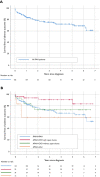Long-term outcome of children with newly diagnosed pulmonary arterial hypertension: results from the global TOPP registry
- PMID: 36972621
- PMCID: PMC10785586
- DOI: 10.1093/ehjqcco/qcad020
Long-term outcome of children with newly diagnosed pulmonary arterial hypertension: results from the global TOPP registry
Abstract
Background and aims: The Tracking Outcomes and Practice in Pediatric Pulmonary Hypertension (TOPP) registry is a global network established to gain insights into the disease course and long-term outcomes of paediatric pulmonary arterial hypertension (PAH). Previously published cohorts in paediatric PAH are obscured by survival bias due to the inclusion of both prevalent (previously diagnosed) and incident (newly diagnosed) patients. The current study aims to describe long-term outcome and its predictors in paediatric PAH, exclusively of newly diagnosed patients.
Methods and results: Five hundred thirty-one children with confirmed pulmonary hypertension, aged ≥3 months and <18 years, were enrolled in the real-world TOPP registry at 33 centres in 20 countries, from 2008 to 2015. Of these, 242 children with newly diagnosed PAH with at least one follow-up visit were included in the current outcome analyses. During long-term follow-up, 42 (17.4%) children died, 9 (3.7%) underwent lung transplantation, 3 (1.2%) atrial septostomy, and 9 (3.7%) Potts shunt palliation (event rates: 6.2, 1.3, 0.4, and 1.4 events per 100 person-years, respectively). One-, three-, and five-year survival free from adverse outcome was 83.9%, 75.2%, and 71.8%, respectively.Overall, children with open (unrepaired or residual) cardiac shunts had the best survival rates. Younger age, worse World Health Organization functional class, and higher pulmonary vascular resistance index were identified as independent predictors of long-term adverse outcome. Younger age, higher mean right atrial pressure, and lower systemic venous oxygen saturation were specifically identified as independent predictors of early adverse outcome (within 12 months after enrolment).
Conclusion: This comprehensive analysis of survival from time of diagnosis in a large exclusive cohort of children newly diagnosed with PAH describes current-era outcome and its predictors.
Keywords: Outcome; Paediatric pulmonary arterial hypertension; Prognosis; Survival.
© The Author(s) 2023. Published by Oxford University Press on behalf of the European Society of Cardiology.
Conflict of interest statement
The co-authors who have received grants, fees, and/or travel meeting support or who serve on advisory boards/steering committees have detailed this using the ICMJE Disclosure Form.
Figures




References
-
- Latus H, Delhaas T, Schranz D, Apitz C.. Treatment of pulmonary arterial hypertension in children. Nat Rev Cardiol 2015;12:244–254. - PubMed
-
- Hansmann G, Koestenberger M, Alastalo T-P, Apitz C, Austin ED, Bonnet Det al. 2019 updated consensus statement on the diagnosis and treatment of pediatric pulmonary hypertension: the European Pediatric Pulmonary Vascular Disease Network (EPPVDN), endorsed by AEPC, ESPR and ISHLT. J Heart Lung Transplant 2019;38:879–901. - PubMed
MeSH terms
Grants and funding
LinkOut - more resources
Full Text Sources
Medical

